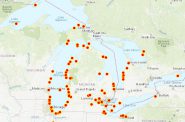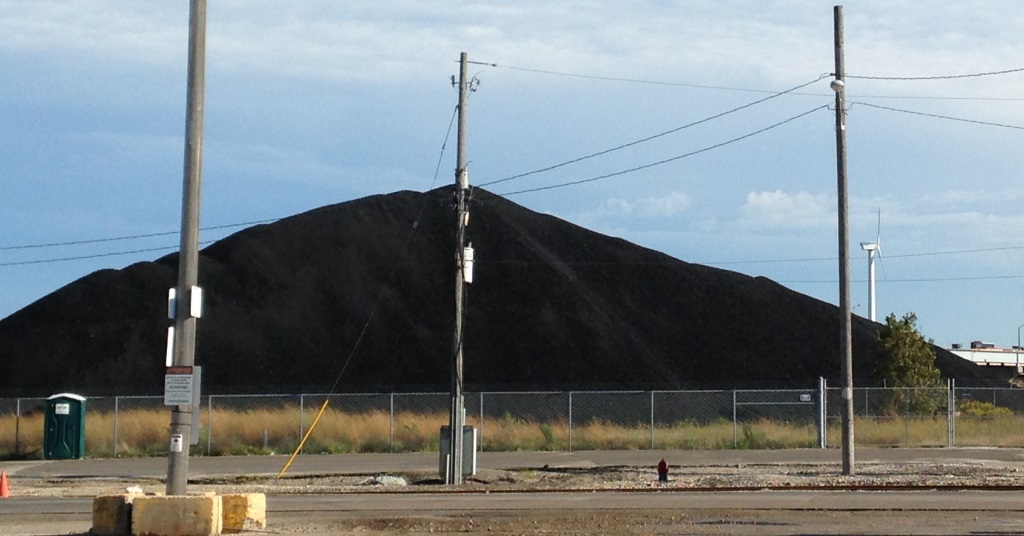Coal Ash Pollutes Midwest States
Most sites pollute groundwater; 6 are in Wisconsin, including We Energy’s Oak Creek plant.
Sometimes pollution is dramatic, like aerial footage of a 2011 coal ash pond collapse that sent toxic contents onto the beach and into Lake Michigan in Oak Creek, Wisconsin, just south of Milwaukee.
In 2011, a bluff holding back coal ash at We Energy’s Oak Creek Power Plant in Oak Creek, Wisconsin, just south of Milwaukee collapsed and 725 cubic yards of ash and soil entered Lake Michigan. Video: WISN 12 News.
Sometimes pollution is hidden, like the toxic cancer-causing, brain-damaging chemicals like arsenic and lithium at elevated levels in groundwater beneath coal plants throughout the country, according to a recent report by the nonprofit Environmental Integrity Project.
That’s a worry because groundwater is the source of much of the nation’s drinking water.
Many of those sites are in Great Lakes states. Illinois, which passed legislation in late May regulating and requiring cleanup of coal ash sites, has 16 polluted sites—the most in the country. Indiana (14) and Michigan (13) are close behind. The remaining Great Lakes states each have multiple contaminated sites: Ohio (10), Pennsylvania (8), Wisconsin (6), Minnesota (3) and New York (2).
In the Great Lakes region, coal ash polluted groundwater at 73 of 80 monitored sites.
Coal ash storage pollutes groundwater nationwide. Some Great Lakes states have the most sites polluted with coal ash.
And many are near bodies of water, making their contamination more likely, said Elena Saxonhouse, a senior attorney at Sierra Club who is working on the group’s Beyond Coal campaign in Michigan.
Pollutants from a coal ash pond at Hatfield’s Ferry Power Station in Masontown, Pennsylvania, have moved through the ground and into a creek where they could contaminate nearby wells, according to Ashtracker, an online tool from Environmental Integrity Project that tracks coal ash around the country.
Ashtracker also reports that at the Bruce Mansfield Power Plant in Shippingport, Pennsylvania, coal ash has polluted local creeks and, local residents believed, drinking water wells. A coal ash landfill in Fredonia, New York, contaminated nearby residential wells.
Consumers Energy’s J.B. Sims Generating Station in Grand Haven is in the middle of the Grand River nears its mouth. Any contaminants getting into the river will flow directly to Lake Michigan, even if they are diluted by that point, Saxonhouse said.
The contaminated groundwater also threatens drinking wells, although the extent of the threat is unknown because coal plants aren’t required to test groundwater outside their property, Saxonhouse said. But it’s still troubling.
“If I were living in a community near a coal ash dump, I would be getting my water tested. No question,” she said. “It’s pretty self-evident you don’t want this in people’s water.”
Some of the states with the greatest number of polluted sites are in the Great Lakes. Many sites are polluted with four or more contaminants.
Environmental groups are concerned about threats to human and environmental health, though they aren’t entirely known because comprehensive monitoring of groundwater around coal ash plants only started in 2015.
“For the first time ever, we all of a sudden had a snapshot of the whole industry,” said Abel Russ, the Environmental Integrity Project report’s lead author and a senior attorney there. The nonpartisan nonprofit group uses data to show the harm done to communities when environmental regulations aren’t fully implemented by the federal and state governments and corporations.
That’s what’s left after power plants burn coal to generate electricity. The ash is stored in landfills or mixed with water and stored in ponds. The Coal Ash Rule regulates storage sites still open in 2015.
After utilities reported in 2018 the results of groundwater testing, Russ and his colleagues crunched the numbers and found widespread contamination: groundwater at 242 of 256 sites had one or more contaminant above the Environmental Protection Agency’s safety limits. In the Great Lakes region, it was 73 of 80 sites.
Because sites retired before 2015 are exempt from monitoring, the problem could be even worse, Russ said.
“I think very roughly half of the coal ash that’s been dumped in the US is probably older units that aren’t regulated,” he said. “The cutoff date might be leading to a slightly rosier picture than we really have.”
In Michigan, most coal plants have a mix of open and retired landfills and ponds, Saxonhouse said.
The unmonitored landfills and ponds could be skewing the numbers at monitored sites, too.
On top of the 91 percent of contaminated sites, another 5 percent could be contaminated by unmonitored coal ash in nearby landfills or ponds that were closed before 2015.
While the bluff collapse was dramatic, cleanup was mostly completed by the next month. A Wisconsin Department of Natural Resources press release reported no lasting harm to human or environmental health. State regulators approved an end to cleanup a year later.
“We worked closely with the Wisconsin DNR and Coast Guard to clean up the debris,” Alison Trouy, a spokesperson for We Energies, said in an email.
Coal ash’s invisible pollution of groundwater is concerning, said Russ.
“If the question is whether people’s drinking water is currently being threatened the answer is yes, but we don’t know how much because nobody’s required to measure off-site residential well water,” he said.
The longer coal ash is allowed to get into groundwater, the more it threatens drinking water.
After the initial reporting deadline in 2018, the Coal Ash Rule allows coal plants flexible timelines to clean up or identify an alternative source of the pollution, which would allow them to avoid cleaning up altogether. Environmental Integrity Project’s report suggests that all coal ash sites should be closed so that toxic chemicals cannot leach into groundwater, now or later, and spread out from the site.
One reason groundwater contamination rates are so high is that a lot of coal ash is stored in ponds and landfills with no impermeable barrier protecting groundwater. Clean up effort would need to address that, Saxonhouse said.
“The ideal is that the company fully excavates the pond and removes the coal ash and disposes of it in a lined landfill with a proper modern synthetic liner,” she said.
The longer ponds are left unlined, the farther pollution can spread.
“These things, if they’re left unaddressed, will get worse over time,” Russ said. “When EPA did their modeling for the Coal Ash Rule they predicted that the peak offsite concentrations wouldn’t occur for decades or even hundreds of years.”
“If you wait a hundred years, much more of those toxic pollutants will be out of the coal ash and in the groundwater, moving away, either into rivers or toward residential wells.”
This story was originally published by Great Lakes Echo.
Great Lakes Echo
-
Tracking Balloon Debris in Great Lakes
 Dec 3rd, 2019 by Tasia Bass Cont
Dec 3rd, 2019 by Tasia Bass Cont
-
Extreme Changes Forecast for Great Lakes
 May 21st, 2019 by Cassidy Hough
May 21st, 2019 by Cassidy Hough
-
State’s Dead Deer Help Detect Disease
 Nov 23rd, 2018 by Kaley Fech
Nov 23rd, 2018 by Kaley Fech





















